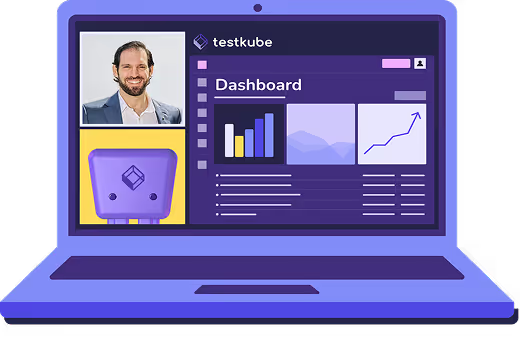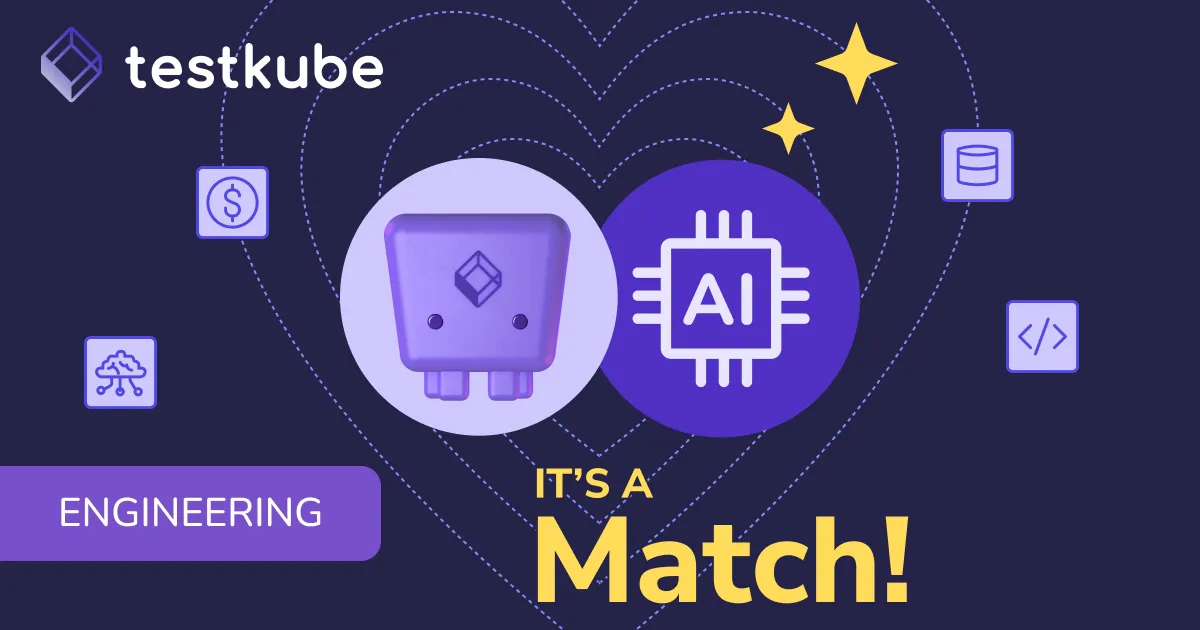

Table of Contents
Try Testkube instantly in our sandbox. No setup needed.
Try Testkube instantly in our sandbox. No setup needed.




Table of Contents
Executive Summary
As software development advances rapidly, the role of testing needs to be reimagined. The rise of AI-powered tools presents new opportunities and challenges that require a fresh approach to quality. Enter "vibe testing."
Inspired by the concept of vibe coding, an AI-assisted software development style popularized by Andrej Karpathy in early 2025, vibe testing draws from this approach to development. Vibe coding is characterized by a fast, improvisational, and conversational workflow where developers and code-focused large language models (LLMs) act as pair programmers in real time, prioritizing rapid iteration and creative problem-solving.
Similarly, vibe testing enhances traditional structured approaches like unit tests, integration tests, and end-to-end tests by blending human intuition with AI's ability to analyze vast datasets and detect hidden patterns. It's the art of knowing when something feels off, combined with the science of data-driven decision making.
This isn't just about running tests; it's about fostering a deeper connection between creativity, data, and decision-making to ensure software quality can actually keep pace with innovation.
So, What Actually is Vibe Testing?
Vibe testing is a dynamic, conversational approach to software testing where testers articulate product requirements and user scenarios in natural language, and AI converts these descriptions into executable tests. Instead of relying on manually coded scripts or rigid test plans, vibe testing thrives on a continuous feedback loop of prompting, generating, running, and refining.
This methodology can be defined by five core principles:
- Conversational: Requirements and test cases are written in plain English, eliminating the need for complex coding.
- Iterative: Rapid cycles of execution, review, and refinement with AI collaboration.
- Creative: Promotes exploratory testing by "vibing" through edge cases and unexpected scenarios.
- AI as a Co-Tester: The AI suggests test cases, identifies gaps, and offers innovative ways to challenge the software.
- Minimal Boilerplate: AI manages the scaffolding and assertions, allowing testers to focus on intent and outcomes.
Vibe testing reimagines software testing as a fluid, exploratory process that aligns with the speed and creativity of modern AI-driven development workflows.
The AI Double-Edged Sword in Software Quality
On a recent episode of The Cloud Native Testing Podcast, Laurent Py, a software quality expert with 20 years of experience, shared insights from recent research by Google's DORA team that reveals a sobering reality: "for every 25% increase in AI generated code, there is a 7.2% decrease in software stability." This statistic highlights that the more teams leverage AI coding assistants and agents to create tests and code, the less stable their delivery becomes.
This statistic isn't meant to discourage AI adoption but to highlight the critical importance of maintaining human oversight in the development process. While AI can accelerate code generation and basic test creation, it needs experienced testers who have strong critical thinking skills to ensure quality doesn't suffer.
Here's the key insight: teams must think about edge cases, carefully review AI suggestions, and avoid the trap of unquestioningly accepting recommendations just because the process becomes significantly easier and frictionless.
The Human Element: Critical Thinking in Testing
Despite AI's capabilities, certain aspects of testing remain distinctly human:
Exploratory Testing with Business Context
A skilled tester brings business knowledge and an understanding of which features are critical for user experience and business operations. They know that not all bugs are created equal: some affect millions of users, while others impact rarely used features.
The exploratory tester knows about the business, understands that certain features are really critical because they're used frequently, or even if they're not used often, when they are used, if they don't work, it breaks the promise to users.
Contextual Decision Making
Human testers absorb knowledge through conversations with customers, understanding of business priorities, and awareness of recent production issues. This contextual awareness guides testing decisions in ways that pure data analysis cannot replicate.
Critical Evaluation of AI Suggestions
Perhaps most importantly, experienced testers have the critical thinking skills necessary to evaluate and refine AI-generated tests and suggestions. A good tester is someone with great critical thinking abilities. The most important skill when using AI is having the critical capability to assess, critique, accept, or refuse the suggestions.
The Future of Testing: Human-AI Collaboration
The future of software testing isn't about choosing between human expertise and AI capabilities; it's about creating effective partnerships between the two. This collaboration model offers several advantages:
- Scaling Expertise: Rather than needing ten testers, teams might achieve better results with five experienced testers augmented by AI, focusing human effort on high-value activities like exploratory testing and strategic quality decisions.
- Faster Feedback Loops: AI can help optimize test execution plans, reducing costs and accelerating delivery while maintaining quality standards. When deploying every commit through CI/CD to production, teams are chasing seconds or minutes for optimization.
- Enhanced Critical Thinking: By handling routine analysis and pattern recognition, AI frees human testers to focus on critical thinking, business context, and exploratory testing activities.
Implementing Vibe Testing with AI Assistance
The key to building an effective AI-testing workflow is:
- Invest in Experienced Testers: AI amplifies the capabilities of skilled testers with strong critical thinking abilities.
- Establish Clear Boundaries: Define what AI handles (data analysis, pattern recognition, routine test generation) versus what humans control (business context, critical decisions, exploratory testing).
- Maintain Data Quality: Ensure your testing and requirement tools provide the comprehensive, unified data that AI needs to make intelligent recommendations across fragmented cloud-native pipelines.
- Continuous Learning: Treat AI suggestions as starting points that require human validation and refinement. Remember: generating exactly what you want often requires significant prompt refinement, sometimes taking as long as doing the work manually.
- Embrace the Single Pane of Glass: Tools like Testkube that provide unified visibility across fragmented cloud-native delivery pipelines become essential for effective AI-human collaboration.
Preparing for the Next Generation
One critical consideration as we embrace AI in testing is ensuring we continue to develop the next generation of skilled testers. There's a growing concern that juniors don't learn effectively while using AI: they don't truly learn, they just apply things. They risk becoming unfamiliar with design patterns and the tough concepts they previously had to master.
The challenge is maintaining the pipeline of expertise that AI amplifies, ensuring that today's junior testers develop the critical thinking skills necessary to be effective AI collaborators tomorrow.
Also, it is important the junior knows when a test that has been generated using vibe testing is ready for production and when it still needs to be refined. AI can allow tests to pass by the way the test is set up, so simply telling AI to check its own testing is not going to work.
The Evolution of Testing
Software testing is evolving into a collaborative ecosystem where human expertise and AI-driven capabilities work in harmony. This shift isn't just about adopting smarter tools; it's a complete redefinition of how quality assurance integrates with today's fast-paced development practices.
AI excels at handling massive amounts of data, identifying patterns, and automating repetitive tasks. But even the most sophisticated AI systems can't replace the critical thinking, domain knowledge, and curiosity that human testers bring to the table. They ask the "what if" questions, explore edge cases, and understand the nuanced business contexts that machines can't quite grasp.
The breakthrough comes when human expertise and AI capabilities are supported by infrastructure designed for rapid iteration. Teams need platforms that can handle the unpredictable nature of vibe testing - executing dynamically generated tests, managing artifacts from multiple iterations, and providing the unified visibility that both humans and AI need to make smart decisions.
Ultimately, organizations that treat testing as a strategic discipline (one that balances cutting-edge technology with human ingenuity) are poised to lead. The goal isn't to replace testers but to empower them through seamless automation, unified processes, and deeper visibility into testing results. By reimagining quality assurance as a partnership between people and technology, we unlock potential that far surpasses what either could achieve alone.


About Testkube
Testkube is a cloud-native continuous testing platform for Kubernetes. It runs tests directly in your clusters, works with any CI/CD system, and supports every testing tool your team uses. By removing CI/CD bottlenecks, Testkube helps teams ship faster with confidence.
Explore the sandbox to see Testkube in action.



